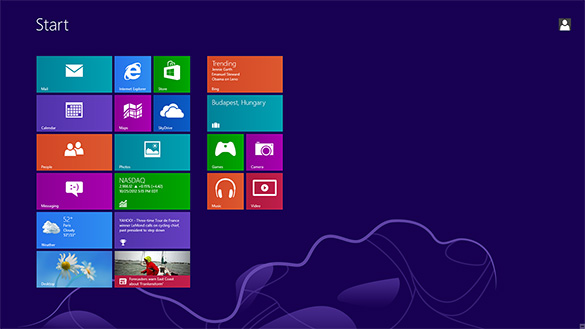Embracing Windows 8 With A New PC System Build
OS and Issues
With the hardware fully assembled, it was time to get the OS installation going. As I mentioned, I’m a stickler when building my personal systems and prefer not to muck with them once they’re done. Before running the Windows installer, I made sure to download all of the latest drivers available for every component, updated the BIOS/UEFI on the mobo, and also all of the latest firmwares (where available) for the other components. If something wasn’t going to work, it wasn’t going to be because a firmware needed updating...

The Much-Maligned Windows 8 Start Screen
With all of the necessary drivers in tow and the system fully updated, I began the Windows 8 installation and was impressed by the speed of the process. Windows 8 Pro x64 was literally installed and running on the system within 15-20 minutes. It helped that I was installing the OS from a fast USB 3.0 thumb drive onto a killer rig, of course, but the swiftness of the installation was appreciated nonetheless.
Once the OS installation was complete, I installed all necessary drivers and ran Windows Update until no more updates were listed. Then I did some basic stability tests, played some games, and got a feel for the system. Unfortunately, once I began poking around, I ran into a few issues.
The first thing I noticed was that the graphics cards weren’t always initializing properly. Sometimes they’d work correctly, but other times, the second card wouldn’t initialize properly, and I couldn’t enable SLI. I tried swapping their positions, using different slots, using a new SLI bridge connector, and experimenting with older firmware revisions, all to no avail. It turned out this issue was related to NVIDIA’s early Windows 8 drivers, and all I could do was wait. NVIDIA’s newer drivers fixed the issue, thankfully, and the graphics cards have been humming along perfectly ever since.
The next issue I came across was related to the Sound Blaster Titanium HD. Creative Labs initial Windows 8 drivers would install and seemed to work properly until the system rebooted, and then I’d have no sound. This issue turned out to be a blessing in disguise though, because while researching the issue I stumbled across PAX’s modified driver packages for the card, which significantly enhanced audio quality in my opinion. I had to wait for Creative to release updated drivers to completely alleviate the issue I mentioned (and for PAX to update with the latest build, too), but once I had the update in hand, the sound card worked properly—most of the time. The only other minor issue that cropped up with the latest drivers only happens when waking the machine from sleep. If I wake the system and immediately play a sound, there is significant crackling and distortion. But once the machine has been awake for a few moments, the distortion goes away.
I never really nailed down the cause or exact resolution of the third issue I came across. Randomly, when powering up the system, it seemed that the SAS controller would not initialize and spin up the hard drives, which caused Windows 8 to hang while booting and forced a system shut down. I’d hit the power button, a few seconds later I’d see the Windows 8 logo, and then the system would just shut back down. I'd hit the power button again, and the rig would fire up normally and work fine. Over the course of the few months that I’ve been using the system, Gigabyte has released a few BIOS updates for the GA-X79S-UP5-WIFI, and Intel has updated their storage drivers, and I've installed both. As of today, I’m using the latest versions of each, and the system starts up fine, but I’m not sure if it was the BIOS update or drivers that fixed it. The issue didn’t happen consistently anyway, so troubleshooting it proved to be difficult. Regardless, I’m glad things are working properly now.






